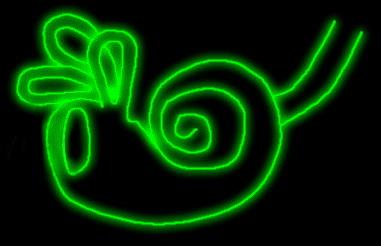The Inner Ear

Oval Window:
|
|
The oval window is a membrane in the wall of the cochlea. It receives vibrations from the stapes in the middle ear, and transfers the vibrations to the fluid of the cochlea.
|
Semicircular Canals:
|
The semicircular canals help maintain balance, but have no function in auditory perception. They contain fluid and specialized hair cells. When the fluid moves, the hair cells send a message to the brain that the head has changed position.
|
Cochlea:
|
The cochlea converts physical vibrations into electrical impulses. In its natural shape, the cochlea is coiled up, but when unraveled it measures 3.5 cm. Inside the cochlea is the basilar membrane, upon which form standing waves caused by the vibration of the fluid inside the cochlea. Depending on the frequencies of the vibrations, the peaks of the standing waves will occur at different points along the membrane. Lower frequencies produce peaks near the end of the membrane far from the oval window, while higher frequencies produce peaks near the end of the membrane closer to the window. Over two million tiny hairs called stereocilia pick up the movement of the basilar membrane and cochlear fluid and then convert the signals into electrical impulses.
|
Auditory Nerve:
|
The auditory nerve is a pathway that allows the neurel signals produced by the stereocilia in the cochlea to travel to the brain. Once in the brain the signals from both ears are combined, processed, and interpreted to produce the sensation that we call hearing.
|

